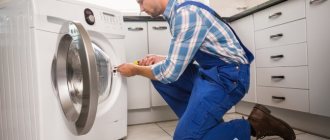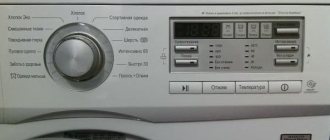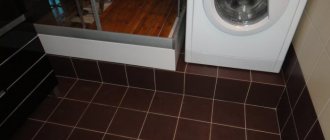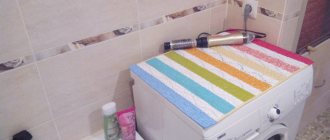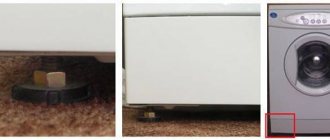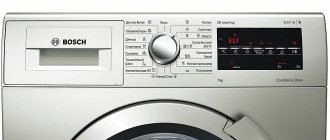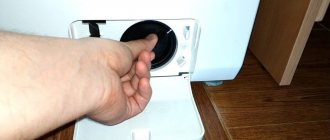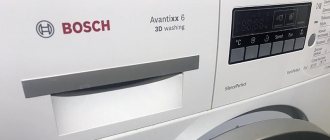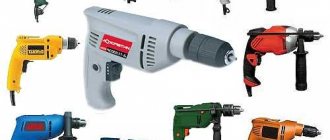Looking at the compact and simple in design Malyutka washing machine, it is difficult to believe that there is a very powerful engine inside it. The manufacturer managed to equip it with a rather large motor, which even had to be placed in a separate housing. But large size is not its only feature. This motor is also known for its highest reliability, as it can serve for many years without accidents. We invite you to take a closer look at the characteristics of the Malyutka washing machine engine and evaluate its advantages and potential.
Types of engines and their speed
How many revolutions are in the washing machine engine must be clarified at the time of purchase.
The efficiency of washing and spinning depends on this. If the maximum motor can “accelerate” the drum to 1400-1800 rpm, things will be almost dry. The engine of an automatic machine converts electrical energy into mechanical energy, thereby spinning the drum. There are 3 types: asynchronous, commutator and inverter electric motors. The design and operating principle of each engine is different.
- An asynchronous motor can be two- or three-phase. If we talk about the power of motors of this type, it varies from 180 to 360 Watts. The speed of these electric motors does not exceed 2800 during spinning and 300 during the main wash. Accordingly, the drum spins even slower.
- Commutator motors can operate by accepting not only direct current, but also alternating current. Their distinctive feature is their compact size. The engine speed is controlled electronically. The main disadvantage of collectors is the brushes, which have to be replaced every few years. The power of electric motors of this type reaches 800 W, and the motor armature is capable of rotating at a frequency of up to 17 thousand revolutions per minute.
- Inverter engines. For the first time, SMAs equipped with ultra-technological motors were released in 2005, based on the innovative development of engineers from the South Korean brand LG. The fundamental difference is that a drive belt is not needed to connect the drum and the engine together. The inverter is small in size and has a relatively simple design. The power of such electric motors is not inferior to collectors; moreover, they are capable of accelerating the “centrifuge” to 1600-2000 rpm.
Washing machines equipped with inverter motors are considered the most reliable and economical.
Inverter engines consume significantly less electricity and do not require periodic maintenance (replacing brushes or drive belts). The disadvantages include the higher cost of direct-drive washing machines.
Tips for use
With careful and proper handling, a washing machine can last much longer and require repairs less often. To do this you need to follow a few simple rules.
- When connecting, you need to carefully select wires based on power, brand and cross-section. Two-core aluminum cables cannot be used, but copper or three-core cables can be used.
- For protection, you must use a circuit breaker with a rated current of 16 A.
- Grounding is not always available in houses, so you need to take care of it yourself. To do this, you will need to separate the PEN conductor and install a grounded outlet. It is better to choose a model with ceramic fittings and a high protection class, especially if the “washing machine” is in the bathroom.
- When connecting, do not use tees, adapters and extensions.
- If there are frequent voltage fluctuations, it is necessary to connect the washing machine through a special converter. A good option is an RCD with parameters no higher than 30 mA. The ideal solution would be to organize catering from a separate group.
- Children should not be allowed near the machine for playing with buttons on the control panel.
Do not change the program during washing.
Engine power and energy consumption
People are often concerned about how many kilowatts the machine will “eat” on average per wash cycle. Many people want the machine to be as economical as possible. In general, the energy consumption of washing equipment depends on many factors:
- motor power - and the amount of electricity consumed by the engine will change, depending on the running washing program;
- technical characteristics of the heating element. The amount of “consumed” kilowatts is also affected by the power of the tubular heater (it varies from 1700 to 2900 W) and the set washing temperature;
- drain pump power, this figure can range from 24 to 40 W;
- total power of indicators, sensors, electronic module and other elements. In general, the figure reaches 5-10 watts.
The energy consumption of a washing machine depends on the power of its motor, pump, heating element and system sensors.
So what indicator should the buyer focus on? On what basis is a washing machine assigned an energy efficiency class? The manufacturer indicates in the technical specifications the energy consumption of the automatic machine when the “Cotton” program is activated. This mode assumes full drum loading and “medium” water heating – up to 60 °C
What experts say
Until now, no dependence has been identified on the speed of the machine, its service life and reliability. All models have different service lives, which are set by the manufacturer, who provides warranties and produces spare parts. Even those models that can spin no more than 600 rpm can still work for a whole decade. However, some manufacturers are reviewing the service life of their devices. Sometimes without even giving official statements about it.
Motor models and their power
If you want to understand in as much detail as possible the technical characteristics of the washing machine you are purchasing, you can clarify which engine it is equipped with. There are enough variations of motors; different manufacturers choose, in their opinion, the optimal engines for their equipment. Let's talk about some models.
- Engine CESET MCA52/64-148/AD You can find this motor on automatic Indesit and Hotpoint-Ariston machines. The engine power is 430 watts, which corresponds to 11.5 thousand revolutions.
- CESET MCA38/64-148/CY15 electric motors are equipped with washing equipment from the Candy, Zerovat and Hoover brands. Characterized by a power of 360 watts, they are capable of accelerating to 13,000 rpm.
- The engine of the CESET CIM2/55-132/WHE1 series is installed on automatic machines manufactured by Whirlpool and Bauknecht. The motor power reaches 800 watts, the speed of revolutions is up to 17 thousand.
- The WELLING HXGP2I.05 WASHING engine is also equipped with Indesit equipment. In addition, such motors can be found on some Vestel models. The maximum power of the engines does not exceed 300 Watts.
- HXGP2I Welling Electronic Control. This electric motor can be found on Samsung and Ardo automatic machines. Their power rating is 300 watts.
Some modern engines can be adjusted by adjusting the speed. For this, a tachogenerator is connected. The sensor will monitor the number of turns and transmit all information to the main control module.
Today, the vast majority of washing machines are equipped with either commutator or inverter motors. Asynchronous two-phase engines are a thing of the past; now they can only be found on older semi-automatic machines, “Fairy” or “Vyatka”.
Source
DIY repair
Despite the simple design and the absence of complex components, “Baby” washing machines sometimes fail. If an electric motor breaks down, it is unlikely that you will be able to repair the unit yourself, but it is quite possible to eliminate a leak, solve a problem with the activator, or change the oil seal on your own. To do this, you need to learn how to disassemble the machine and adhere to a certain repair scheme.
Disassembly
Before any repairs, the unit is disconnected from the network and placed on a flat, well-lit surface. Before disassembling the machine, experts recommend waiting 5-7 minutes so that the capacitor has time to discharge. Then remove the plug from the hole located on the back side of the motor casing, align the hole in the impeller with the hole in the casing and insert a screwdriver through it into the engine rotor.
The activator is carefully unscrewed, after which the tank is disconnected. Next, unscrew 6 screws, remove the flange and unscrew the locknut and rubber nut that secure the switch.
Then remove the washers and unscrew the screws holding the casing halves together. These parts are carefully removed to gain access to the electric motor and other equipment.
Repairing the activator
One of the common problems with the activator is a violation of its mobility, and, as a result, stopping the washing process. This can happen from overloading the tank, as a result of which the engine starts to run at high speeds, the machine hums, and the blades stand still. To eliminate this problem, it is enough to unload the tank and give the motor a rest, while in more serious cases, disassembling the activator is required. A common reason for the impeller stopping is threads and rags wrapping around the shaft. To eliminate the malfunction, the activator is removed and the shaft is cleaned of foreign objects.
A misalignment of the activator can also become a serious problem in which, although it continues to spin, it strongly wrinkles and even tears the laundry.
At the same time, the machine makes a strong hum and may periodically turn off. To solve the problem of misalignment, the activator is removed and the thread is cleaned, after which it is reinstalled in place, controlling its position.
Fixing a leak
Leaks also sometimes occur when using “Malyutki” and cause unpleasant consequences. Leaking water can reach the electric motor and cause a short circuit and even an electric shock. Therefore, if a leak is detected, you must immediately take measures to eliminate it, without ignoring the problem. You need to start by finding the location of the leak: usually it turns out to be a flange assembly or a large o-ring. To do this, the machine is partially disassembled and the rubber is inspected for damage. If defects are detected, the part is replaced with a new one.
If the large ring is in order and water continues to flow, then disassemble the casing and remove the flange assembly. Then it is disassembled and the rubber bushing and small spring ring are inspected, which sometimes does not compress the cuff too well. If necessary, it is replaced with a tighter one or bent.
Pay attention to the small o-ring, although it does not leak as often. Hose fittings can also leak. In this case, you need to remove the worn element and install a new one.
Replacing oil seals
The oil seal is located between the tank and the engine, and a leak may indicate the need to replace it. Usually the oil seal is changed together with the activator, since often its sleeve is literally torn by the thread into which the shaft is screwed. The new node is installed in place, then a test connection is made.
If the electric motor fails, there is no point in repairing it, since the cost of repairing it is comparable to buying a new Malyutka. Fortunately, engines do not break down too often and, if operating rules are followed, they can last 10 years or more.
Source
What is the power of the SM engine
The performance of the motor depends on its type. Three types of washing machines are used:
- asynchronous;
- collector;
- inverter (brushless).
Asynchronous motor
It was installed in cars manufactured before 2000. The motor of a semi-automatic washing machine has 2800 rotations per minute and a power of 180–360 W. To adapt such an engine for garage “homemade” products, you need a three-phase network, a frequency converter, and a set of capacitors. This is expensive, which is why asynchronous systems are not popular among do-it-yourselfers.
Brushed motor
A favorite of the masters. Powered by direct and alternating electric current, power 300–800 W, number of armature turns 11,500–15,000 rpm. On the plus side, the cycle can be easily adjusted without loss of power. The downside is that the brushes wear out often.
Types of stepper motors according to the type of connection of stator electromagnets:
According to the type of connection of electromagnets, stepper motors are divided into: unipolar and bipolar.
The figure shows a simplified, schematic representation of the windings. In fact, each winding consists of several windings of electromagnets connected in series or parallel
- A bipolar motor has 4 terminals. Pins A and A feed winding AA, pins B and B feed winding BB. To turn on the electromagnet, a potential difference (two different levels) must be applied to the winding terminals, which is why the motor is called bipolar. The direction of the magnetic field depends on the polarity of the potentials at the terminals.
- A unipolar motor has 5 leads. The central points of its windings are connected to each other and are the common (fifth) output, which is usually connected to GND. To turn on the electromagnet, it is enough to apply a positive potential to one of the winding terminals, which is why the motor is called unipolar. The direction of the magnetic field depends on which winding terminal the positive potential is applied to.
- A 6-pin motor has taps from the center points of the windings, but winding AA is not connected to winding BB. If you do not use the terminals of the central points of the windings, then the motor will be bipolar, and if these terminals are connected and connected to GND, then the motor will be unipolar.
- The 8-pin motor is the most flexible in terms of connecting electromagnets. This motor can not only be used as bipolar or unipolar, but you can also determine for yourself how to connect the electromagnets of the windings, in series or in parallel.
Read also: Do-it-yourself bicycle with a chainsaw motor
The device of the commutator electric motor of an automatic washing machine
The appearance of motors of different models may differ, but the design and operating principle are almost identical. The device consists of:
- housings;
- starter;
- starter coils (shoes) with two or three terminals;
- anchors;
- pulley;
- two brushes;
- collector;
- tachometer (with two or three wires);
- terminal block.
To connect the motor, you need to know the outputs of the armature, starter and tachometer windings. A tester will help you avoid getting tangled in wires.
Easy motor connection
Set the tester to the mode of least resistance and call the windings of the tachometer, coils and armature. Make connections through terminals that communicate with each other. A correctly connected device picks up speed smoothly, does not crackle or spark. You can check how many revolutions the motor makes using a speed sensor.
A visual step-by-step implementation can be seen in this video:
General information:
A stepper motor is a brushless motor whose rotor does not rotate smoothly, but in steps (discretely). A complete revolution of the rotor consists of several steps. By changing the signal shape, the number of pulses, their duration and phase shift, you can set the rotation speed, direction of rotation and the number of revolutions of the motor rotor.
Stepper motors consist of a rotor (moving part) and a stator (fixed part). Electromagnets are installed on the stator, and the parts of the rotor that interact with the electromagnets are made of hard magnetic (permanent magnet motor) or soft magnetic (jet engine) material.
How to adjust rotation
There are many ways to control speed:
- laboratory autotransformer;
- adjustment board for household appliances;
- screwdriver buttons, grinders;
- lighting regulators (switches, toggle switches).
The adjustment scheme is simple, you can do it yourself.
This is a satisfactory option for a pump or fan. For more powerful mechanisms (for example, machine tools), a different regulator circuit will be needed.
The essence of the question is how to reduce speed without losing performance? The connection is made through a tachogenerator, which transmits the number of turns to the speed controller microcircuit, which coordinates the cycle using a thyristor.
Such a board allows you to either increase or decrease the speed, but requires constant, intensive cooling due to overheating. A detailed video about how the speed and power of the stroke are regulated by connecting to the microcircuit can be viewed here:
Now you know what speed different types of engines make and how to set up this process in your home workshop. Good luck!
Source
Necessary unnecessary things
Many people will simply take the car to a junkyard and forget about it. But this is not a solution to the problem for a zealous and skillful owner. You would be surprised to know where and what parts of a washing machine could be used in a household. And in our article we will talk about the most valuable part of this unit - the working engine of an automatic washing machine.
The most suitable option for using an electric motor is to connect it to another device. For example, an electric grinding machine (or any other). But to do this, first of all, you need to connect the motor to a 220 V household network and adjust the number of its revolutions.
Correct connection of the commutator motor
Whatever the engine power of an automatic car, it must be controlled correctly. Therefore, it is important to be able to regulate the speed.
Let's figure out how to connect a commutator motor and identify the wires of the tachometer, which acts as a speed controller.
- In some motors, the stator and rotor terminals can be identified by color. As shown in the photo below, the first two white wires are the tachometer outputs. You won't need them to connect yet. Red and brown are the stator wire, gray and green are the rotor.
Need a diagram
If you have found a use for the working motor from an automatic washing machine that has become unnecessary, you should figure out how the motor is connected to the electrical network. Before starting work, you need to carefully study the electrical connection diagram of the engine and understand how it worked in the washing machine.
Connecting the electric motor occurs quite quickly, it does not take much time. Initially, it may seem that there are too many wires coming from the engine. However, after analyzing the diagram presented above, you will understand that not all of them will be used. You will have to work specifically with the rotor and stator wires.
How to independently regulate the motor speed
How to regulate the engine speed of an automatic and semi-automatic washing machine? You can do this with your own hands through a board (chip) or voltage regulator. Let's look at both methods in more detail.
Connection via regulator
To do this, you can use a rotary wheel, a dimmer, or a drill trigger. This method will tell you how to increase or decrease the engine speed. That is, by turning the installed wheel, you can control the incoming voltage to the motor from a 220 Volt network.
The connection goes according to the following diagram:
- According to the diagram, one wire of the stator winding is connected by an armature (rotor).
- Then one rotor wire is connected to the speed controller.
- The remaining wire of the stator and rotor is connected to a 220 Volt network.
Please note that the electric motor must be secured before connecting. Because when turned on at full power, it can jump off the table.
When you start the engine, you will find that it is working at full capacity. If you try to set the speed control using the wheel, you will notice that the speed is immediately lost and the motor stops. That is, there can be no talk of normal work.
But we have another, more effective method.
Connection via board (chip)
How to control speed using a control board? The tachogenerator is used here. The sensor itself cannot control anything; it must be connected correctly. This is what the microcircuit is used for. The connection is made according to the regulator circuit based on TDA 1085.
What revolutions can the motor make with this connection? From high to low. In this case, you will not need to rotate the regulator by hand; you can control the speed through the toggle switch.
If you try to create a load on the electric motor, the speed will immediately decrease, after which it will resume with new power. This is because the sensor interacts with the board, sending a signal to reduce power.
Those who are versed in electrical engineering will be able to assemble such a board themselves. The list of parts is presented in the table below. You can do it easier and order such a microcircuit in an online store.
Now you know how not only to connect, but also to properly adjust the operation of the engine. You can safely begin experiments in creating home appliances.
Source
Frequency regulation
Just recently (10 years ago), there were a limited number of frequency controllers for motor speeds on the market, and they were quite expensive. The reason was that there were no cheap high-voltage power transistors and modules.
But developments in the field of solid-state electronics have made it possible to bring power IGBT modules to the market. As a result, there is a massive appearance on the market of inverter air conditioners, welding inverters, and frequency converters.
At the moment, frequency conversion is the main way to regulate the power, performance, speed of all devices and mechanisms driven by an electric motor.
However, frequency converters are designed to control three-phase electric motors.
Single-phase motors can be controlled by:
Converters for single-phase motors
Currently, only one manufacturer announces serial production of a specialized inverter for capacitor motors - INVERTEK DRIVES.
Optidrive E2 model
For stable engine starting and operation, special algorithms are used.
In this case, frequency adjustment is possible upward, but in a limited frequency range, this is prevented by a capacitor installed in the phase-shifting winding circuit, since its resistance directly depends on the frequency of the current:
C – capacitance of the capacitor
The output stage uses a bridge circuit with four output IGBT transistors:
Optidrive E2 allows you to control the motor without removing the capacitor from the circuit, that is, without changing the motor design - in some models this is quite difficult to do.
Advantages of a specialized frequency converter:
Disadvantages of using a single-phase inverter:
